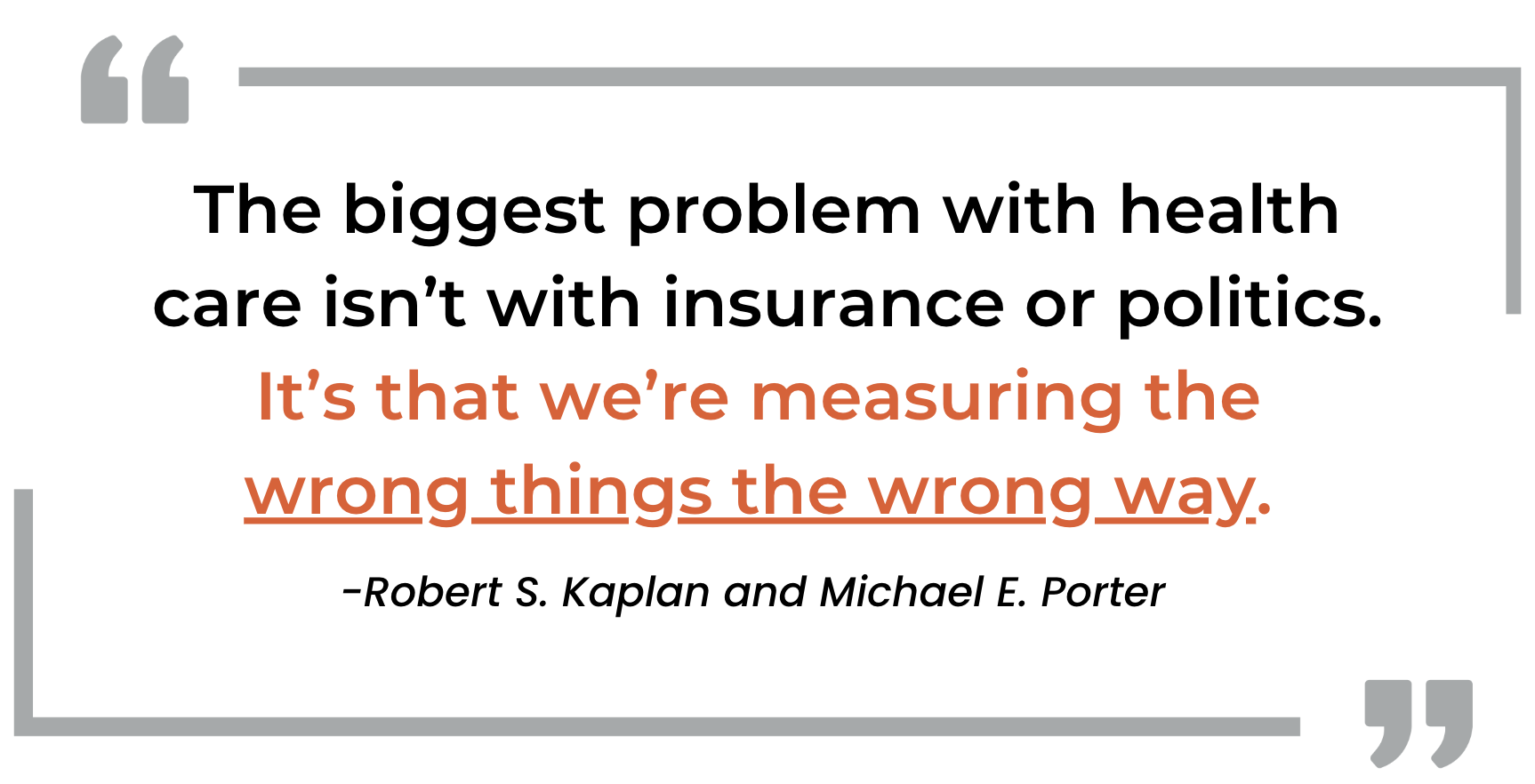
Measuring Clinical Laboratory Contributions
Are we doing it wrong relative to the clinical laboratory?
To cut to the chase, the answer is YES.
In a HBR article by Kaplan and Porter entitled “How to Solve the Cost Crisis in Health Care” they succinctly summarized the root cause of the problem as follows:
The Disconnect
This practice of measuring the wrong things the wrong way, per Kaplan/Porter, distorts our perceptions of aggregate costs and allows patient outcomes, if tracked, to be disconnected from costs which obscures value.
We have made progress in some areas of healthcare in this regard since the Kaplan/Porter article was first published in 2011, but not to a significant degree in the clinical laboratory.
To understand why this lack of progress is an issue concerning the clinical laboratory let us first review the lab’s key characteristics. The community hospital clinical laboratory, with an effective diagnostic integration (outreach) program:
- Generates 70% of the objective information in a patient’s medical record.
- Produces information that triggers or confirms most healthcare costs in today’s environment, this impact will increase significantly with precision medicine.
- Touches every patient’s care in nearly every care setting.
- Is a core competency in every healthcare system and a critical element in population health, care coordination, and new health system care delivery models.
- Represents a light manufacturing environment with excess capacity concerning its plant and equipment after peak acute care needs have been met.
- Generates incremental profitable revenue in support of the health system’s patient care mission.
Despite these characteristics and the associated opportunities, fee-for-service reimbursement and fragmented health care delivery allowed us to focus on the price per test in isolation, rather than the aggregate costs of providing patient care.
It should be kept in mind that inexpensive tests performed by laboratories that are not part of the health system can be very expensive when viewed within the context of the episode of care costs, staff efficiency, and patient service levels.
As an example, the delays in receiving test results for patient samples that leave the community will likely cause delays in making the definitive diagnosis which will frustrate staff, delays initiating the patient’s definitive treatment and possibly delay the hospital discharges.
“Despite these characteristics and the associated opportunities, fee-for-service reimbursement and fragmented health care delivery allowed us to focus on the price per test in isolation, rather than the aggregate costs of providing patient care.”
In addition, the search for cheap laboratory tests often results in multiple laboratories being engaged in providing test results across the community’s continuum of patient care. The associated fragmentation of diagnostic processes and test results that occurs make establishing a consistent patient centric community-wide diagnostic record significantly more difficult if not impossible preventing the potential efficiencies that would result from an integrated consistent diagnostic record across the health system’s primary service area.
From a management perspective we continue to manage the clinical laboratory as a budgetary silo without taking critical cross-functional operational interdependencies that exist between the lab and the other hospital and clinical departments into account as well as the possible negative impact on care settings across the community’s continuum of care.
We also persist in measuring cost of each line item in isolation, ignoring possible cross functional efficiencies, rather than measuring outcomes and aggregate cost of care. This approach often leads to unintented and costly “penny wise and pound foolish” decisions.
A Change of Focus
A more appropriate approach for managing the health system clinical laboratory, because of its light manufacturing operating model, concerns a focus on its unit costs rather than its budget and its service levels and its episode of care impact rather than the price per test.
Laboratories managed in this manner will be well positioned to execute a community diagnostic integration strategy which will help:
- Improve patient outcomes and service levels
- Lower episode of care costs
- Reduce hospital length of stay
- Avoid unnecessary ED visits and hospitalizations
- Reduce staff frustrations
- Generate profitable incremental margin in support of health system’s patient care mission
Fee-for-service reimbursement hid many of these opportunities, but they will be revealed as we measure the right things about the clinical laboratory in the right way in preparation for patient-centric, value-based care, and a more at-risk reimbursement environment.

We are at a strategic fork in the road that requires a new perspective
To bring these opportunities into sharper focus the clinical laboratory needs to borrow a chapter from pharmacy and its Pharmacoeconomics initiatives.
Pharmacoeconomics is the scientific discipline that compares the value of one pharmaceutical drug or drug therapy to another. Pharmacoeconomics involves three primary approaches:
- Cost-effectiveness analysis – involves a comparison of costs in achieving a particular non-monetary objective, such as lives saved, health improvement.
- Cost-effectiveness ratio – consists of estimating the change in social costs (e.g., resources, money) as the numerator and the change in health (e.g., disability or functionality, shortened or prolonged life) as the denominator.
- Cost benefit analysis – involves measuring all benefits and costs which are directly or indirectly attributable to the outcome under investigation.
Similarly, Labacoeconomics™ is the recognition and accountability for the value that the health system’s clinical laboratory can generate within the context of a patient’s episode of care as we stop thinking about the lab in isolation.
This perspective is key because the majority of health system benefits generated by its clinical laboratory reside outside the laboratory.
To reduce the chances of making “penny wise, and pound foolish” decisions, these benefits must be considered when making strategic decisions regarding the clinical laboratory and its diagnostic processes.
Five Important Things to Remember:
1) Focus should be on patient care and the practice of laboratory medicine, not the laboratory industry and the price per test.
2) Laboratory data represents 70% of the patient’s information in their medical record triggering most healthcare costs – it requires local oversight.
3) Utilizing multiple laboratories across the health system’s continuum of care creates:
- Fragmented community diagnostic information – making care coordination more difficult.
- Inconsistent data – making effective population health and diagnostic optimization difficult if not impossible.
4) The laboratory is involved in every patient’s care in nearly every care setting. A fact that needs to be leveraged to a far greater degree for the health systems to thrive in value-based care and at-risk reimbursement.
5) The health system clinical laboratory is well suited to become more accountable for delivering value within the context of the episode of care across the continuum of patient care.
These benefits, fully executed, significantly exceed the cost per test and the laboratory’s budget!
In Summary
An effective and efficient community healthcare system must have an efficient and effective clinical laboratory as an agile integrated local partner. For that to occur the clinical laboratory must grow.
To bend the healthcare cost curve, health system and laboratory leadership must operationalize care differently and measure the right things the right way.
Leveraging clinical laboratory and laboratory expertise as a core competency across all service-lines and care settings represents a significant opportunity to position community health systems to:
- Prepare for the value-based care and expanded at-risk reimbursement.
- Generate incremental revenue and margin in support of the health system’s patient care mission.
Pathologists and laboratorians should borrow from pharmacy’s experience and Pharmacoeconomics and begin to build out Labacoeconomics™ to:
- Implement key Labacoeconomics™ principles to facilitate measuring the right things the right way regarding the clinical laboratory.
- Engage more with clinical colleagues to optimize their test ordering patterns.
- Redefine the laboratory’s valuable role within the context of the patient’s episode of care.
- Ensure that appropriate strategic decisions regarding the lab are made.
Source Article:
HBR article by Kaplan and Porter mentioned above “How to Solve the Cost Crisis in Health Care”
Additional Reading
The Community Clinical Laboratory of the Future
Shifting Focus From Lab Industry To Lab Medicine
Hospital Laboratory Outsourcing and its Unintended Consequences
Think Twice Before Selling Your Hospital Outreach Lab
- Labacoeconomics™: Expanding the Role of Clinical Laboratories in Value-Based Healthcare - February 26, 2024
- Pace of Hospital Lab Acquisitions Likely to Remain Steady - April 29, 2023
- Measuring Clinical Laboratory Contributions - April 29, 2023
